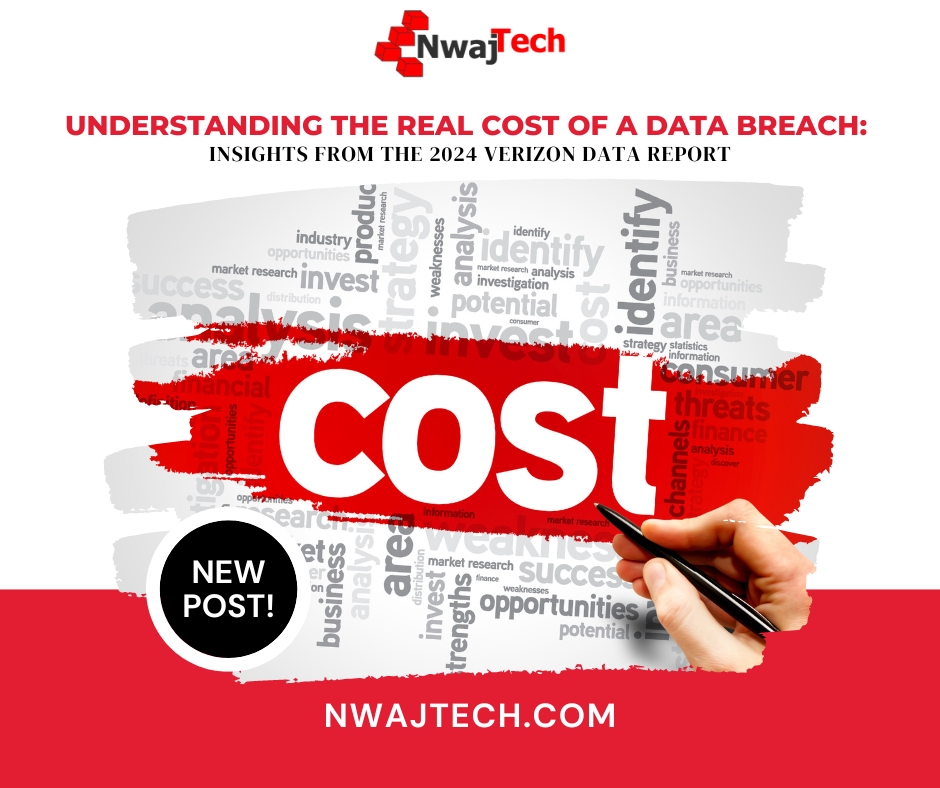
Understanding the Real Cost of a Data Breach: Insights from the 2024 Verizon Data Breach Report
The “Cost of a Data Breach Report 2024” conducted by the Ponemon Institute and sponsored by IBM, provides critical insights into the financial impacts of data breaches and highlights emerging trends that organizations need to address. At Nwaj Tech, we believe in the proactive adoption of Zero Trust cybersecurity solutions, and this report underscores the importance of such measures in the current threat landscape. Here is our take on the 2024 Verizon Data Breach Report
Key Findings from the 2024 Verizon Data Breach Report
- Rising Costs of Data Breaches: The report reveals a significant 10% increase in the global average cost of a data breach, now standing at USD 4.88 million. This increase, the largest since the pandemic, is primarily driven by business disruptions and post-breach customer support costs. For businesses, this highlights the financial risk associated with insufficient cybersecurity measures.
- The Role of AI and Automation: Organizations that extensively use AI and automation in their security operations have seen substantial cost savings. On average, these technologies reduced breach costs by USD 2.2 million. They also help speed up the detection and containment of breaches, reducing the overall impact. At Nwaj Tech, we integrate advanced AI tools into our Zero Trust solutions, providing our clients with cutting-edge defenses.
- Cyber Skills Shortage: A growing shortage of cybersecurity professionals is another critical issue highlighted in the report. More than half of the organizations surveyed reported significant staffing shortages, a factor that correlates with higher breach costs. Addressing this skills gap is crucial for effective breach prevention and response.
- Data Types and Breach Impact: Nearly half of the breaches analyzed involved customer personal data, which includes sensitive information like tax ID numbers and home addresses. The presence of shadow data—data stored in unmanaged environments—was also noted in 35% of breaches, significantly increasing costs. This finding stresses the need for comprehensive data governance and secure data management practices.
- Geographic and Industry-Specific Insights: The United States reported the highest average breach cost at USD 9.36 million, while the healthcare sector remained the most expensive industry for breaches despite a slight reduction in costs. These variations underline the importance of tailored cybersecurity strategies that address specific regional and industry risks.
 According to the “Cost of a Data Breach Report 2024,” the most common tactics used in data breaches are:
According to the “Cost of a Data Breach Report 2024,” the most common tactics used in data breaches are:
- Phishing and Stolen or Compromised Credentials: These are the two most prevalent attack vectors. Phishing accounted for 15% of the breaches, while compromised credentials were involved in 16%. These methods are among the top four costliest types of incidents, with phishing resulting in an average breach cost of USD 4.88 million, and compromised credentials slightly less at USD 4.81 million .
- Malicious Insider Attacks: Although less frequent, making up 7% of breaches, these attacks are the most costly, averaging USD 4.99 million per incident. This type of attack typically involves employees or other insiders misusing their access to steal or compromise data .
- Human Error and IT Failures: Nearly half of all breaches were attributed to these causes, highlighting the importance of training and proper system management. Specifically, IT failures accounted for 23% of breaches, while human error was responsible for 22% .
- Use of Shadow Data: Shadow data, which refers to unmanaged or untracked data, was involved in 35% of breaches. These breaches are particularly costly, with the average cost of breaches involving shadow data being 16% higher than those without .
- Business Email Compromise (BEC) and Social Engineering: These tactics involve manipulating individuals into divulging confidential information or transferring funds. BEC and social engineering attacks are significant contributors to data breaches, particularly in compromising credentials and facilitating unauthorized access .
Recommendations for Reducing Breach Costs
Adopt a Zero Trust Framework: Zero Trust is no longer just an option but a necessity. A Zero Trust approach ensures that all access requests are thoroughly vetted by assuming that threats can arise from both outside and inside the network.
Leverage AI and Automation: Investing in AI and automation can dramatically improve your security posture. These technologies enhance threat detection and response times and free up your cybersecurity team to focus on more complex challenges.
Address the Cyber Skills Gap: Consider upskilling your current workforce and investing in continuous education programs. Collaborating with cybersecurity specialists, like those at Nwaj Tech, can also provide the expertise needed to safeguard your digital assets.
Enhance Data Governance: Implement comprehensive data management strategies that include identifying and securing shadow data. Regular audits and the use of data security posture management tools can help prevent unauthorized access and data breaches.
At Nwaj Tech, we’re committed to helping businesses navigate the complexities of cybersecurity. The findings from the “Cost of a Data Breach Report 2024” reinforce the need for robust, adaptive security measures. By adopting a Zero Trust approach, leveraging advanced technologies, and addressing skills shortages, businesses can significantly reduce the financial and reputational damage associated with data breaches.
For more information on how Nwaj Tech can help your organization strengthen its cybersecurity posture, contact us at 888.91.CYBERm. Stay vigilant, stay secure.
